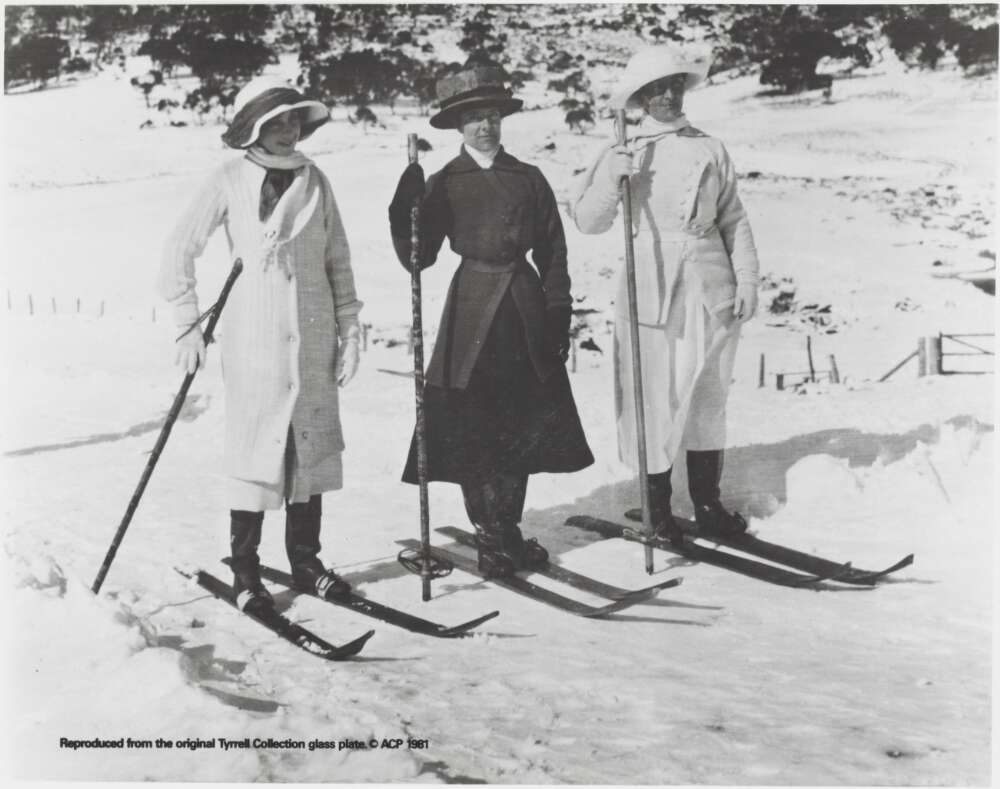If you saw a woman wearing pants while skiing today, you probably wouldn’t bat an eye, but you would have a century ago. Early female skiers often wore the same long, heavy skirts on the slopes that they wore in their everyday lives. By the end of the 1930s, ski pants were a standard item in a woman’s ski wardrobe. So, what caused the shift from bulky skirts to the streamlined pants you see nowadays?
Our story begins with the invention of the bicycle. Bikes may seem unrelated to the snowy slopes, but they kickstarted important developments in women’s participation in sports culture and the adoption of female trousers. In the late 1880s, the safety bicycle was invented and made the new form of transportation less dangerous. With fewer risks associated with the bicycle, women felt more inclined to adopt the new mode of travel. Ladies of the 1890s harnessed the bicycle to achieve the freedom associated with increased mobility. Catherine Smith, a professor of the arts, notes how these “New Women” on their “wheels” were seen as a threat because of their independence and desire for adventure. Rather than staying in the home where they “belonged,” women could explore the world around them and learn new ideas about women’s rights.

Source: Library of Congress. In the Public Domain. https://www.loc.gov/item/2012648801/
Skirts impeded women’s ability to ride, so they began to wear voluminous trousers inspired by Turkish clothing. However, Smith states that women wearing bloomers were the exception, and most women wore split skirts with a flap to cover the gap. According to Smith, “women who wore bloomers would be ridiculed in the press,” which often condemned woman it deemed too outspoken or manly. Cartoons would depict women who threatened the status quo with their bloomers and bicycles and who stepped outside of gender expectations. Women in bloomers were seen as violating the submissive and domestic roles assigned to them by society. Because of the pushback, limited numbers of women adopted bloomers around the turn of the century.
The adoption of trousers for biking followed the general trends of women’s sportswear in the late 19th to early 20th century. In the latter half of the 19th century, leisure and sport increased in popularity due to their health benefits. However, Yhe-Young Lee, a fashion historian and former chief editor of the International Journal of Costume and Fashion, notes that women were only encouraged to engage in “moderate” physical activity to avoid damaging their reproductive systems. While there were fears about women engaging in “too much” exercise, women were allowed to participate in the sports culture from which they had previously been excluded. Young-Min Lee and Youn-Hee Lee, two fashion historians, posit that sports and recreation serve to “liberate ourselves from our everyday routines in our workplaces and offices.” As seen with the bicycle, the women experienced additional liberation from some of the constraints of femininity through sports. Women could escape their domestic duties through sports and leisure, which opened potential avenues for the women’s rights movement.
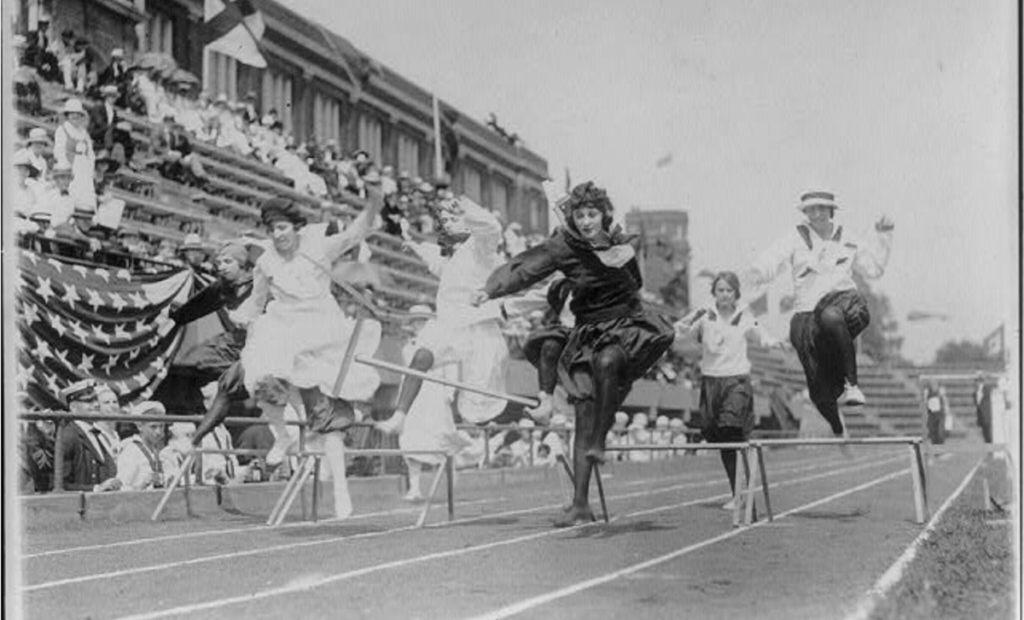
Source: Library of Congress. In the Public Domain. https://www.loc.gov/resource/cph.3b12953/
Women began to break barriers that restricted them from sports, but they lacked the clothing appropriate for their new activities. Patricia Campbell Warner, a costume historian, details that women did not have clothes fit for physical activity, so they had to modify their existing clothes to fit new demands. There wasn’t distinct sportswear, so most women adapted their everyday clothing through minor alterations. In some cases, sporting women could adopt new clothes, like bloomers, that were not appropriate outside of the context of exercise. Clothes for physical activity in private spaces, such as women’s schools, were allowed to be more radical in their adoption of practical pants. In these environments, women’s sportswear ventured ahead of what was acceptable and pushed gender boundaries. However, Warner notes that most sports took place in the public sphere, so women had to dress modestly to accommodate their interactions with men. Women’s sportswear could be more radical in the private sphere, but most sports, like skiing, took place in the open. Therefore, the challenge remained: How do women remain modest and fashionable while providing the functionality required for physical activity?
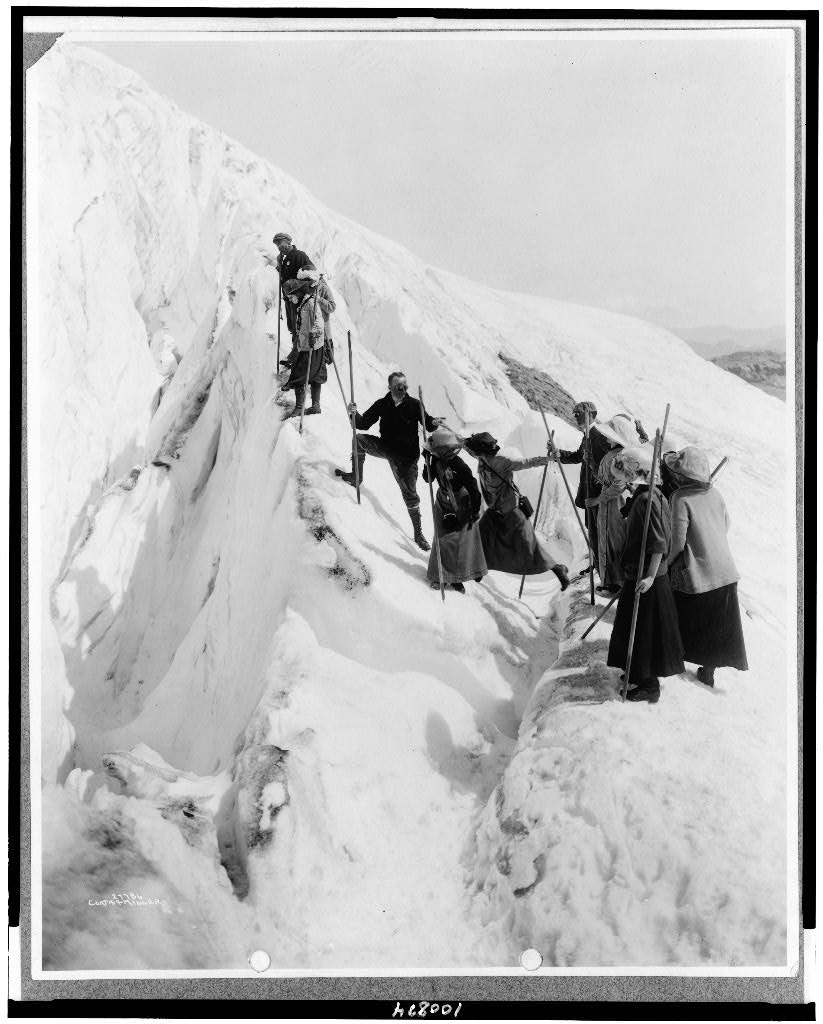
Source: Library of Congress. In the Public Domain. https://www.loc.gov/resource/cph.3c00874/
According to Young-Min and Youn-Hee Lee, skiing required more strenuous training than other sports, so women’s fashion was less regulated. In skiing, emphasis was placed on functionality to accommodate the unique dangers presented when skiing in snowy mountains. However, this does not necessarily mean that women’s ski fashion immediately embraced trousers on the slopes. Early women’s ski wear adapted the styles worn by female mountaineers: thick, long skirts that reached to their ankles. While these may seem cumbersome, the ankle-length was seen as less restrictive than the typical skirts that reached the floor. Fashion historian Maria Echeverri explains the fact that the skirts were modeled after the slender “turn-of-the-century style, popularized by the Gibson Girls.” Gibson girls were ideal feminine figures of the late 19th and early 20th centuries, so adopting their fashions would ensure that female skiers remained fashionable… even if this meant limiting functionality.
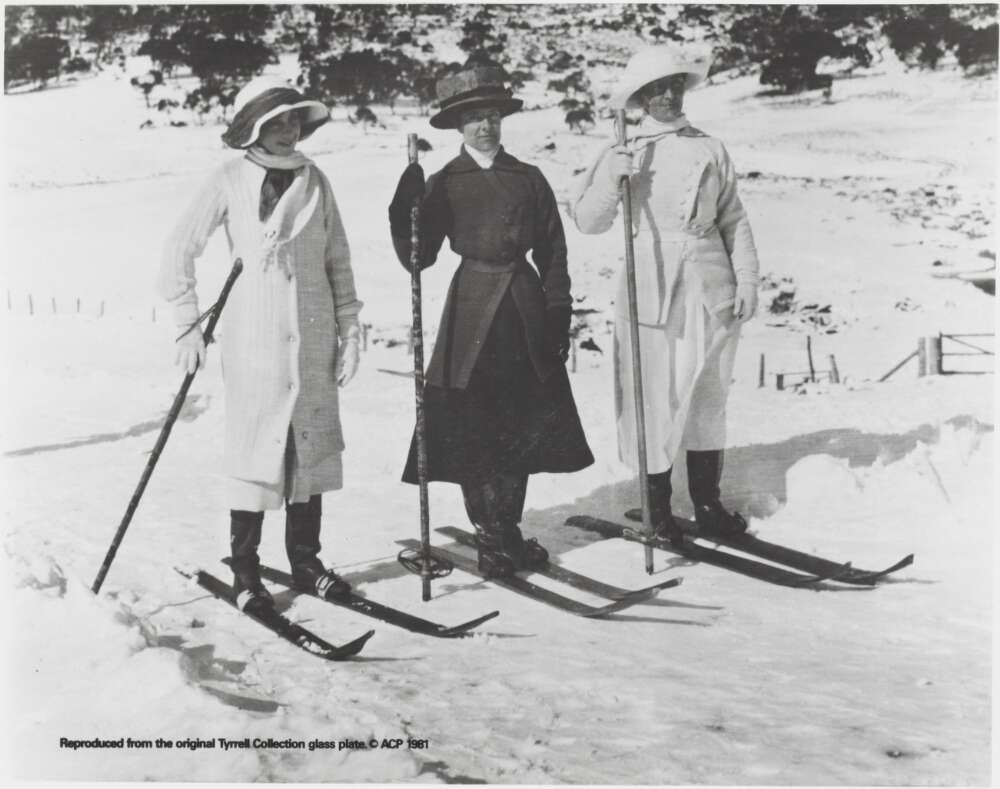
Source: National Library of Australia. In the Public Domain. https://nla.gov.au/nla.obj-138927790/view
While they may not have been as bulky as earlier skirts, Lucy Johnston, the former curator of the Department of Textiles and Dress at the Victoria and Albert Museum, notes that the long skirts would drag through the snow and become heavy, which impeded women’s ability to ski quickly. Because of these difficulties, female skiers in the 1910s shifted to skirts that reached just below the knee worn over a pair of knickerbockers. At last, pants had been introduced to female ski fashion, although in a more acceptable manner with the added skirt. Additionally, Yhe-Young Lee notes that women had to wear stockings or cloth gaiters over their calves since the knickerbockers only reached just below their knees. To preserve their modesty and provide added warmth, extra coverage was necessary.
As mentioned before, the strenuous nature of skiing allowed women to adopt unconventional fashions on the slopes. The knickerbockers and knee-length skirts were not as accepted outside of the sport, so skiing presented opportunities for women to escape some of the fashion conventions of the time. According to Johnston, towards the later part of the 1910s, ski experts began advocating for women to get rid of the skirt entirely when skiing, but recreational skiers appeared to be hesitant to embrace this radical shift at the time. There was an ongoing struggle between fashion and functionality.
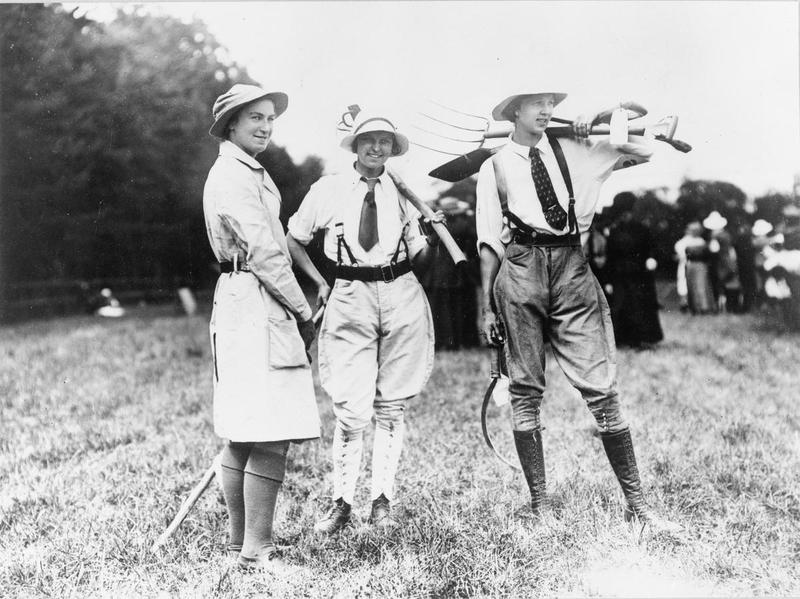
Source: Imperial War Museums, Wikimedia Commons. In the Public Domain. https://commons.wikimedia.org/wiki/File:The_Womens_Land_Army,_1917_Q114811.jpg
But, as we move towards the 1920s and 30s, the distinctions between what was fashionable and what was functional began to merge. Most female skiers ditched the additional skirt in the 1920s. Johnston states that during World War I, women involved in the British Land Girls services wore breeches or knickerbockers. After the war, the uniforms that these women wore were beginning to influence the fashion on the slopes. According to Lucy Johnston, “The acceptance of this type of ski-wear was largely because the respectability of war work had begun to break down social taboos surrounding exposing the legs and wearing breeches.” Pants had finally become fashionable on the slopes.
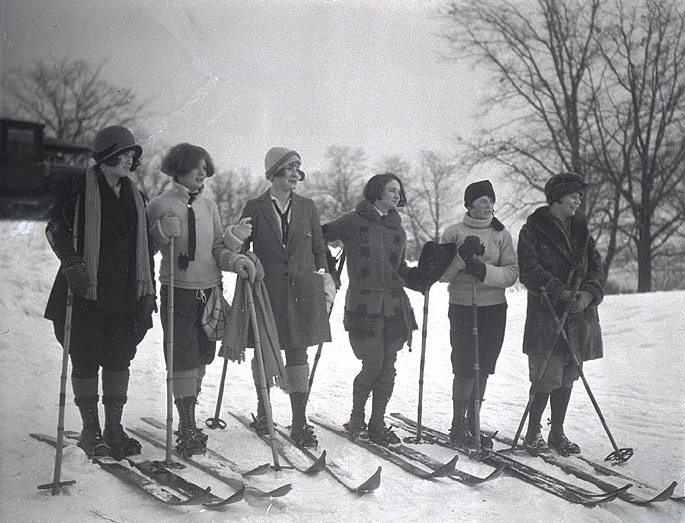
Source: Archives of Ontario, Wikimedia Commons. In the Public Domain. https://commons.wikimedia.org/wiki/File:Skiers_in_High_Park_1925.jpg
The consumer culture of the 1920s spread the acceptance of trousers on the slopes further. Johnston describes how fashion-conscious women began to embrace trousers because of images of women wearing pants in magazines and advertisements. Annie Gilbert Coleman, an American Studies professor, asserts that “images emphasized the streamlined and modern female body, a nod perhaps to the independence and mobility skiing represented during a time when women were moving more freely through public spaces than ever before.” The 1920s saw the ratification of the 19th Amendment in the United States, which granted women the right to vote. Yhe-Young Lee describes how more middle-class women worked for wages, thus giving them greater economic independence as well. Women had growing social, political, and cultural power in the Roaring Twenties, and they chose to display some of this power through their clothing. Flappers emerged during this decade of change and pushed fashion boundaries. Yhe-Young Lee describes how “tubular dresses with low waistlines and skirts showing calves became popular among women in the 1920s.” Shorter hemlines and exposed legs were the subjects of fierce criticism. Many were scared of women defying traditional femininity, but the flappers revolutionized what clothes could be considered feminine and acceptable. Both on and off the slopes, women’s fashion was experiencing a transformation.
By the 1930s, women wearing trousers on the ski slopes had been fully established as fashionable, and female film stars and socialites were often photographed in trousers as they skied. Princess Alexandra of Greece was often seen in alpine ski resorts sporting a pair of form-fitting trousers throughout the mid to late 1930s. In the 1937 film, “I Met Him in Paris,” American actress Claudette Colbert can be seen wearing trousers as she skis alongside her male co-stars. Women started wearing trousers off the slopes as well. Yhe-Young Lee notes that Hollywood stars, such as Katherine Hepburn and Marlene Dietrich, popularized masculine tailored suits and trousers. However, women’s trousers were mostly worn in homes or resorts, and they were not fully acceptable garments to wear out and about.
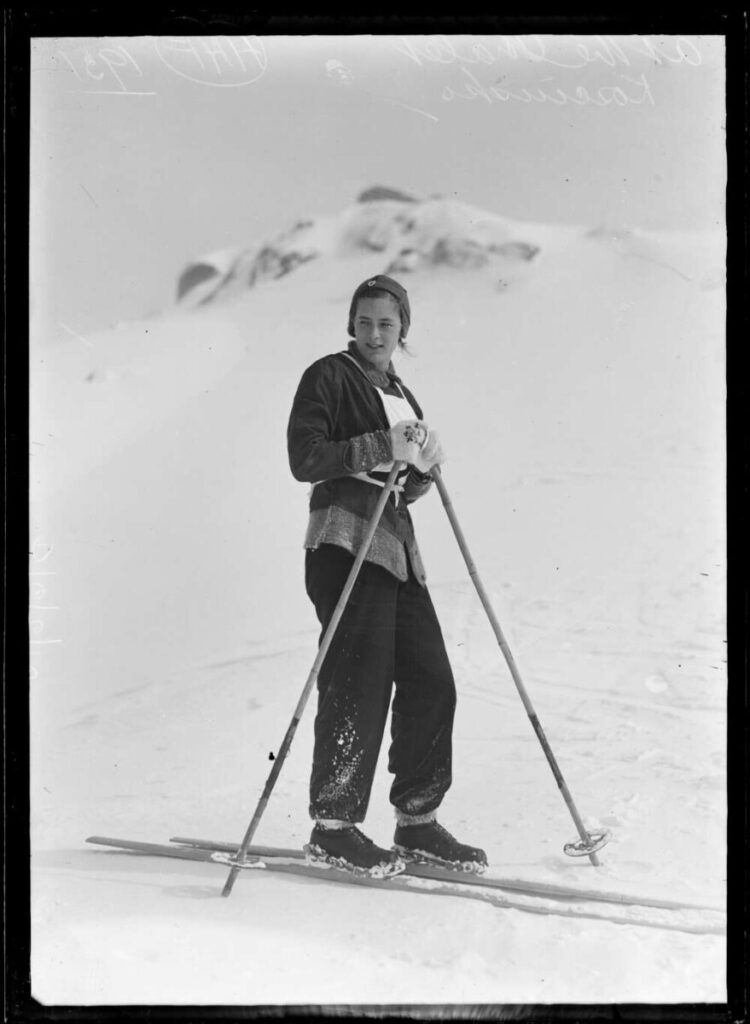
Source: National Library of Australia. In the Public Domain. https://nla.gov.au/nla.obj-163327735/view
In the 30s, women’s pants were shifting away from the baggy knickerbockers and towards more streamlined clothing. According to Nicole Roosien, the creative director of a ski apparel company, skiers became interested in aerodynamics and opted to wear tighter-fitting garments. The voluminous skirts and spacious knickerbockers of the first two decades of the 20th century had been swapped for form-fitting pants that reduced air resistance.
Ski clothing manufacturers also started to attempt to waterproof ski clothing. Tim Willoughby, an Aspen historian, argues that “skiwear’s first priority in the 1930s was practical, to keep you dry.” Echeverri states that, up to this point, most ski clothing was made out of wool, but manufacturers began experimenting with waterproof tweed and gabardine fabrics. Willoughby notes that gabardine was a fabric “more impervious to melting snow”, which kept it drier for longer.
The 1930s also saw the emergence of designated “ski apparel”. The Colorado Snowsports Museum highlights how skiers did not shop for ski-specific clothing before the 1930s, and they would adapt their existing winter clothing for skiing. While it may seem surprising that the category of specific ski apparel would emerge during the same decade as the Great Depression, Lisa Feinberg Densmore, a former competitive skier and writer for numerous ski magazines, notes skiing was still a sport primarily reserved for elites at this time. This explains why Saks 5th Avenue was able to introduce the first “designer ski wear” amid the Depression in 1937. Tim Willoughby details how a women’s gabardine jacket and pants set would be $14.90 at an Aspen ski apparel store around 1940. When adjusted for inflation, this set would cost $321.24 today, demonstrating just how expensive this designated ski apparel was. Therefore, skiers of more modest means likely continued to adapt their regular winter wardrobes for skiing.
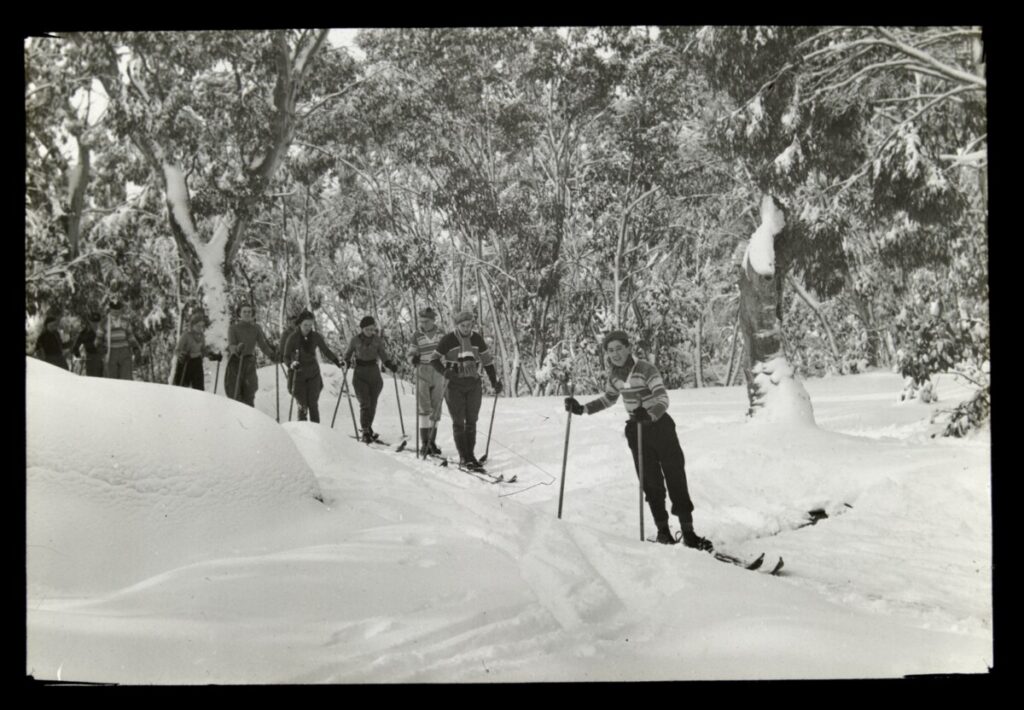
Source: State Library Victoria. In the Public Domain. http://handle.slv.vic.gov.au/10381/84910
Ultimately, women’s ski wear in the early 20th century both adopted the traditions of women’s fashion and pushed the boundaries of what was deemed acceptable. Necessitated by practical concerns associated with skiing in an unforgiving snowy environment, female skiers were able to adopt pants decades before they were appropriate in everyday life. Skiing gave women opportunities for liberation from their established gender roles, and the ski slopes served as a unique arena for advancing women’s rights as a whole. Once women conquered the mountains, everything else seemed attainable too.
Acknowledgements
I would like to thank the Colorado Snowsports Museum, especially Dana Mathios, for assisting with my research for this project. Here is a link to their website, which includes many useful resources about ski history: https://www.snowsportsmuseum.org/. Additionally, I would like to thank the Library of Congress, the National Library of Australia, and the State Library Victoria for providing the wonderful images of female skiers shown throughout this blog. Lastly, I would like to thank Professor Miller for supporting me through this project.
Bibliography
Bauer, Thomas. “The View of a Catholic Writer on the Winter Sportswoman: Henry Bordeaux in the 1920s.” Aethlon 28, no. 2 (Spring, 2011): 99-113. https://link.gale.com/apps/doc/A325174372/LitRC?u=emory&sid=bookmark-LitRC&xid=59d9d449.
“Colorado Snowsports Museum’s Ski Fashion Timeline & Information.” Colorado Snowsports Museum. Accessed April 16, 2023. https://www.snowsportsmuseum.org/digital-resources.
Coleman, Annie Gilbert. Ski Style: Sport and Culture in the Rockies. Lawrence, Kan: University Press of Kansas, 2004. http://www.jstor.org/stable/j.ctt1dgn5pw.
Densmore, Lisa Feinberg. “The Evolution of Style.” Snow Country, January 1996. https://books.google.com/books?id=SRkdYvmRGGYC&printsec=frontcover#v=onepage&q&f=false.
Echeverri, Maria. “History of Ski Wear – Part One.” Snow Comparison (blog). January 20, 2014. https://snowcomparison.com/magazine/history-of-ski-wear-part-one/.
Echeverri, Maria. “History of Ski Wear – Part Two.” Snow Comparison (blog). January 20, 2014. https://snowcomparison.com/magazine/history-of-ski-wear-part-two/.
Johnston, Lucy. “She and Ski: The Development of Women’s Ski Outfits, 1880–1930.” Costume 38, no. 1 (2004): 86-99.
Lee, Young-Min, and Youn-Hee Lee. “A Study of the Historical Change of American Sportswear-Focusing on Women’s Sportswear.” The International Journal of Costume Culture 7, no. 2 (2004): 135-150. https://koreascience.kr/article/JAKO200430710433581.pdf.
Lee, Yhe-Young. Controversies about American Women’s Fashion, 1920–1945: Through the Lens of “The New York Times”. Iowa State University, 2003. https://dr.lib.iastate.edu/entities/publication/3cb859ec-9ef1-4a16-ac70-cbf2762d425a.
Roosien, Nicole. “Ski Fashion Throughout the Years: The Good, The Bad, The Ugly.” Liftopia (blog). Last modified April 14, 2015. https://blog.liftopia.com/ski-fashion-years/.
Skogen, Aunika. “Evolution of Ski Fashion Through the Decades.” Snow Brains (blog). Last modified January 21, 2022. https://snowbrains.com/evolution-of-ski-fashion-through-the-decades/.
Smith, Catherine. Women in Pants : Manly Maidens, Cowgirls, and Other Renegades. New York: H.N. Abrams, 2003.
Warner, Patricia Campbell. When the Girls Came Out to Play The Birth Of American Sportswear. Amherst: University of Massachusetts Press, Project MUSE, 2006. https://www-jstor-org.proxy.library.emory.edu/stable/j.ctt5vk4v1.
Willoughby, Tim. “Willoughby: Ski Fashion of the 1930s — More Practical Than Pretty.” Aspen Times. Last modified December 20, 2020. https://www.aspentimes.com/news/ski-fashion-of-the-1930s-more-practical-than-pretty/.

